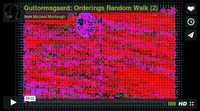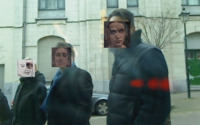Surveillance update: some projects connected to camera surveillance.
Brussels Map of Surveillance Cameras
More than 20 years ago, Constant and Nicolas Malvé started to map surveillance camera’s in Brussels. In 2000 they wrote: “Surveillance cameras have become an integral part of the urban landscape. Their number has grown as much as the degree to which they leave us indifferent - immensely so. Constant proposes to make an inventory of these electronic eyes in Brussels.”
At first glance this page might seem a retro retake of vintage html, but it is in fact the original site that has stayed online ever since.
E-traces
When it started and when it might end?
Surveillance Cameras
https://constantvzw.org/site/Surveillance-camera-map-POA-2010.html
In 2010 and 2011, Denis Devos and Peter Westenberg made with Constant and La Ligue des Droits de l’homme several works around camera-surveillance. We organised walks across the city and the law, to match the legal framework and the reality of the city. We captured videos from wireless surveillance camera’s, in collaboration with lawyer Frank Dumortier (Crids Namur). Also some more playful walks were organised, where we spied on the spycams, and made excercises to hide from the surveilling camera’s.
http://www.videomagazijn.org/info/archives/510
http://www.videomagazijn.org/info/archives/472
Stare
Together we analysed the captured images to see what legal framework applies. It was useful for the League to address privacy problems with the ’surveillance camera law’. This became eventually the artwork/instruction video Stare, in which the images are combined with his voice over.
Here’s some info and also the links to the video:
http://www.videomagazijn.org/info/archives/462
Camera Cartography workshops
We continued doing cartography workshops, where we note camera positions in the city and check if they are announced on the list of the privacy commission.
Usually we have some activists / specialists / jurist present who is knowledgeable abou t the subject and makes the walk into a discursive collective exercise.
http://www.gallery.constantvzw.org/index.php/ballade-sous-surveillance
Here’s one where we walked with 20 people from the center to constant +
http://pleinopenair.constantvzw.org/map/spip.php?rubrique3
This one is started, but never finished because some hackers want to join the sous-surveillance.net maps that are now being made in France.
http://www.surveillance.constantvzw.org/
http://www.gallery.constantvzw.org/index.php/poa
This workshop also included reviewing the safety of the ’mobib’ cart of the STIB. We showed in the metro that the cards can easily be read by anyone who buys a simple card scanner.
Here’s some images of the one we made with Erg students. (An Mertens and Peter Westenberg)
http://www.networkedsocial.constantvzw.org/?p=959
http://gallery3.constantvzw.org/index.php/ERG-Surveillance-cameras
https://constantvzw.org/site/New-translation-Video-Surveillance.html
Footfall Almanac
Footfall Almanac 2020 collects observations, objects and other traces to instigate a discussion on surveillance techniques currently deployed in shopping malls, at Winterpret and other major events in Brussels. Wireless tracking of mobile phones has become a common method to monitor crowds without requiring explicit permission or active cooperation. Private companies as well as civil agencies use it to keep a close eye on the movements of city dwellers through public spaces, the former to forecast sales and the latter for crowd management purposes. Footfall Almanac 2020 observes this encounter of actors and predictions in their shared technologies and terminologies.
This vitrine and publication are part of an ongoing research project developed by Alex Zakkas and Kurt Tichy.
The publication Footfall Almanac 2019 contains visual and textual essays, listing the overlapping vocabularies to address the movements of pidgins on the square or movements in the underground parkinglot. You can download the book or order a printed copy.
Amulets
The amulets were made in a series of workshop in 2021. These amulets offer ways to resist surveillance by confusing the systems of counting people, but also by reminding us of the pleasure of walking around the city without surveillance. These systems are deployed in large cities - such as Brussels - and work by keeping track of survey requests sent by WiFi devices - such as smartphones. Wireless tracking of mobile phones has become a common method of monitoring crowds without requiring explicit permission or active cooperation. Private companies as well as civilian agencies are using it to track the movements of city dwellers in public spaces, the former to predict sales and the latter to manage crowds.
Technopolice
In 2021, the collective Technopolice proposed a collaborative surveillance map in the context of Constant_V.
The deployment of “Smart city” (security) tools aiming at controlling, monitoring, classifying, punishing in order to orient and regulate behaviors is often done in the most total indifference, thanks to the complicity between the industry and the political decision makers; The latter are in the best of cases guilty by negligence or naivety, when they are not themselves at the origin of the adoption of these freedom-icidal gadgets (ANPR cameras recognizing license plates, facial recognition, drones flying over public space and in particular demonstrations, smart energy meters, etc. ).
Our objective is to make visible the threats of freedom-icide that these control tools represent in the Brussels region, by centralizing the information about them on a single platform accessible to all. Through this informative work, we wish to give everyone the possibility to understand these stakes, to build tools and strategies of resistance against surveillance, so that the deployment of these police tools is stopped, that the militarization of the public space is put in check and that, finally, the technopolicing stops!


